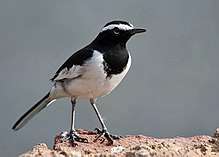Motacillidae
The wagtails, longclaws and pipits are a family, Motacillidae, of small passerine birds with medium to long tails. There are around 65 species in 6 genera. The longclaws are entirely restricted to the Afrotropics, and the wagtails are predominantly found in Europe, Africa and Asia, with two species migrating and breeding in Alaska. The pipits have the most cosmopolitan distribution, being found across mostly in the Old World but occurring also in the Americas and oceanic islands such as New Zealand and the Falklands. Two African species, the yellow-breasted pipit and Sharpe's longclaw, are sometimes placed in a separate seventh genus, Hemimacronyx, which is closely related to the longclaws.[1]
| Motacillidae | |
|---|---|
 | |
| White-browed wagtail (Motacilla maderaspatensis) | |
| Scientific classification | |
| Kingdom: | Animalia |
| Phylum: | Chordata |
| Class: | Aves |
| Order: | Passeriformes |
| Superfamily: | Passeroidea |
| Family: | Motacillidae Horsfield, 1821 |
| Genera | |
Most motacillids are ground-feeding insectivores[2] of slightly open country. They occupy almost all available habitats, from the shore to high mountains. Wagtails prefer wetter habitats to the pipits. A few species use forests, including the forest wagtail, and other species use forested mountain streams, such as the grey wagtail or the mountain wagtail.
Motacillids take a wide range of invertebrate prey, especially insects are the most commonly taken, but also including spiders, worms, and small aquatic molluscs and arthropods. All species seem to be fairly catholic in their diet, and the most commonly taken prey for any particular species or population usually reflects local availability.
With the exception of the forest wagtail, they nest on the ground,[2] laying up to six speckled eggs.
Description
Wagtails, pipits, and longclaws are slender, small to medium-sized passerines, ranging from 14 to 17 centimetres in length, with short necks and long tails.[2] They have long, pale legs with long toes and claws, particularly the hind toe which can be up to 4 cm in length in some longclaws. There is no sexual dimorphism in size. Overall the robust longclaws are larger than the pipits and wagtails. Longclaws can weigh as much as 64 g, whereas the weight range for pipits and wagtails is 15–31 g. The plumage of most pipits is dull brown and reminiscent of the larks, although some species have brighter plumages, particularly the golden pipit of north-east Africa. The adult male longclaws have brightly coloured undersides. The wagtails often have striking plumage, including grey, black, white, and yellow.
Species and genera
Based on recent genetic analysis, this family is thought to consist of six clades: two sub‐Saharan African clades, a New World clade, a Palaearctic clade, a widespread large‐bodied Anthus clade, and a sixth widespread genus, Motacilla.[3]
.jpg)
_in_Kolkata_W_IMG_4336.jpg)

.jpg)

Family: Motacillidae
- Genus Dendronanthus
- Forest wagtail, Dendronanthus indicus
- Genus Motacilla: typical wagtails
- Western yellow wagtail, Motacilla flava – possibly paraphyletic
- Eastern yellow wagtail, Motacilla tschutschensis – possibly paraphyletic
- Citrine wagtail, Motacilla citreola – possibly paraphyletic
- Cape wagtail, Motacilla capensis
- Madagascar wagtail, Motacilla flaviventris
- Grey wagtail, Motacilla cinerea
- Mountain wagtail, Motacilla clara
- White wagtail, Motacilla alba – possibly paraphyletic
- Pied wagtail, Motacilla alba yarrellii
- Black-backed wagtail, Motacilla alba lugens
- African pied wagtail, Motacilla aguimp
- Mekong wagtail, Motacilla samveasnae
- Japanese wagtail, Motacilla grandis
- White-browed wagtail, Motacilla madaraspatensis
- São Tomé shorttail Motacilla bocagii
- Genus Tmetothylacus
- Golden pipit, Tmetothylacus tenellus
- Genus Macronyx: longclaws
- Cape longclaw, Macronyx capensis
- Yellow-throated longclaw, Macronyx croceus
- Fülleborn's longclaw, Macronyx fuellebornii
- Sharpe's longclaw, Macronyx sharpei - sometimes placed in genus Hemimacronyx
- Abyssinian longclaw, Macronyx flavicollis
- Pangani longclaw, Macronyx aurantiigula
- Rosy-throated longclaw, Macronyx ameliae
- Grimwood's longclaw, Macronyx grimwoodi
- Genus Anthus: typical pipits
- Richard's pipit Anthus richardi
- Paddyfield pipit Anthus rufulus
- Australian pipit Anthus australis
- New Zealand pipit Anthus novaeseelandiae
- African pipit Anthus cinnamomeus
- Mountain pipit Anthus hoeschi
- Blyth's pipit Anthus godlewskii
- Tawny pipit Anthus campestris
- Long-billed pipit Anthus similis
- Nicholson's pipit Anthus nicholsoni
- Wood pipit Anthus nyassae
- Buffy pipit Anthus vaalensis
- Plain-backed pipit Anthus leucophrys
- Long-legged pipit, Anthus pallidiventris
- Meadow pipit Anthus pratensis
- Tree pipit Anthus trivialis
- Olive-backed pipit Anthus hodgsoni
- Pechora pipit Anthus gustavi
- Rosy pipit Anthus roseatus
- Red-throated pipit Anthus cervinus
- Buff-bellied pipit Anthus rubescens
- Water pipit Anthus spinoletta
- Eurasian rock pipit Anthus petrosus
- Nilgiri pipit Anthus nilghiriensis
- Upland pipit Anthus sylvanus
- Berthelot's pipit Anthus berthelotii
- Striped pipit Anthus lineiventris
- African rock pipit Anthus crenatus
- Short-tailed pipit Anthus brachyurus
- Bushveld pipit Anthus caffer
- Sokoke pipit Anthus sokokensis
- Malindi pipit Anthus melindae
- Yellow-breasted pipit Anthus chloris - sometimes placed in genus Hemimacronyx
- Alpine pipit Anthus gutturalis
- Sprague's pipit Anthus spragueii
- Yellowish pipit Anthus lutescens
- Short-billed pipit Anthus furcatus
- Pampas pipit Anthus chacoensis
- Correndera pipit Anthus correndera
- South Georgia pipit Anthus antarcticus
- Ochre-breasted pipit Anthus nattereri
- Hellmayr's pipit Anthus hellmayri
- Paramo pipit Anthus bogotensis
- Madanga, Anthus ruficollis
References
- Voelker, Gary; Scott V. Edwards (1998). "Can weighting improve bushy trees? Models of cytochrome b evolution and the molecular systematics of pipits and wagtails (Aves: Motacillidae)". Systematic Biology. 47 (4): 589–603. doi:10.1080/106351598260608. PMID 12066304.
- Clancey, P.A. (1991). Forshaw, Joseph (ed.). Encyclopaedia of Animals: Birds. London: Merehurst Press. pp. 172–173. ISBN 1-85391-186-0.
- Pietersen, D.W.; McKechnie, A.E.; Jansen, R.; Little, I.T.; Bastos, A.D.S. (2019). "Multi‐locus phylogeny of African pipits and longclaws (Aves: Motacillidae) highlights taxonomic inconsistencies". Ibis. 161 (4): 781–792. doi:10.1111/ibi.12683.
External links
| Wikimedia Commons has media related to Motacillidae. |
- Motacillidae videos on the Internet Bird Collection